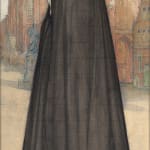Nico Jungmann (1872-1935)
Nico Jungmann was born in Amsterdam in a family with no connections to the arts.[1] At the early age of twelve, he was apprenticed to a decorative painter, where he was taught to paint murals. After four years of training, his talent was recognized and he enrolled at the local art academy, the Rijksakademie. With a scholarship from Arti & Amicitiae, the young artist moved to London in 1893 planning to send sketches of London life back home. In 1897, the famous Volendam inn keeper Spaander visited a large international tourism exhibition in London, accompanied by his two daughters in village folklore costume and Jungmann, lending weight to its artistic appeal.[2] This followed a return to his homeland to work in picturesque Volendam, a place of attraction for the international art scene at the turn of the twentieth century.
In 1900, Jungmann married Beatrix Mackay with whom he had three children. Jungmann made several excursions and illustrated travel books. Each travelogue featured illustrations of the locals with their characteristic features and customs. Jungmann traveled extensively to Holland, Brittany, Normandy, Italy, and Belgium. At the outbreak of the First World War, as a naturalized Briton, Jungmann was interned in Berlin in 1916 The art produced while in detention is now in London’s Imperial War Museum. Separated from his wife during the war, the couple divorced in 1918.
From his arrival in London, Jungmann successfully showed with the Dowdeswell, the Leicester and Rembrandt Galleries. He made his debut at the Royal Academy in 1897, continuing to show there until 1923. He participated in national and international exhibitions in Munich, Paris, and Brussels. A raving review in The Studio compared Jungmann’s drawings to the Holbeins at Windsor Castle or the etchings of Rembrandt: a promising star.
On his travels, Jungmann would make detailed drawings of the scenery, adding his model carefully afterwards before applying color. With self-made crayons, Jungmann’s drawings approximate Japanese woodcuts, fashionable at the turn of the century. The present large-scale drawing combines his fondness for depicting ‘picturesque Holland’ with his affinity to render ‘beautiful women’. Although in the Dutch cities traditional costume was vanishing at the end of the nineteenth century, Jungmann’s idealization of a frozen life turns a blind eye on modernity. With Haarlem’s imposing St Bavo as a backdrop, Jungmann places his model as a polychrome statuette. The Gothic church provided the ideal environment for the symbolist artist flocking to The Netherlands for inspiration.
[1] Biographical information from: E.B.S., “Some drawings by Mr. Nico Jungmann”, The Studio 12-14 (February 1898), no. 59, pp. 25-30
[2] Brian Dudley Barrett, North Sea Artists’ Colonies, 1880-1920, doctoral thesis, Groningen 2008, p. 217
Provenance
Private collection, United KingdomTennants Auctioneer, North Yorkshire, United Kingdom, 14 November 2020, lot 1007
Gallery 19c, Westlake, Texas



